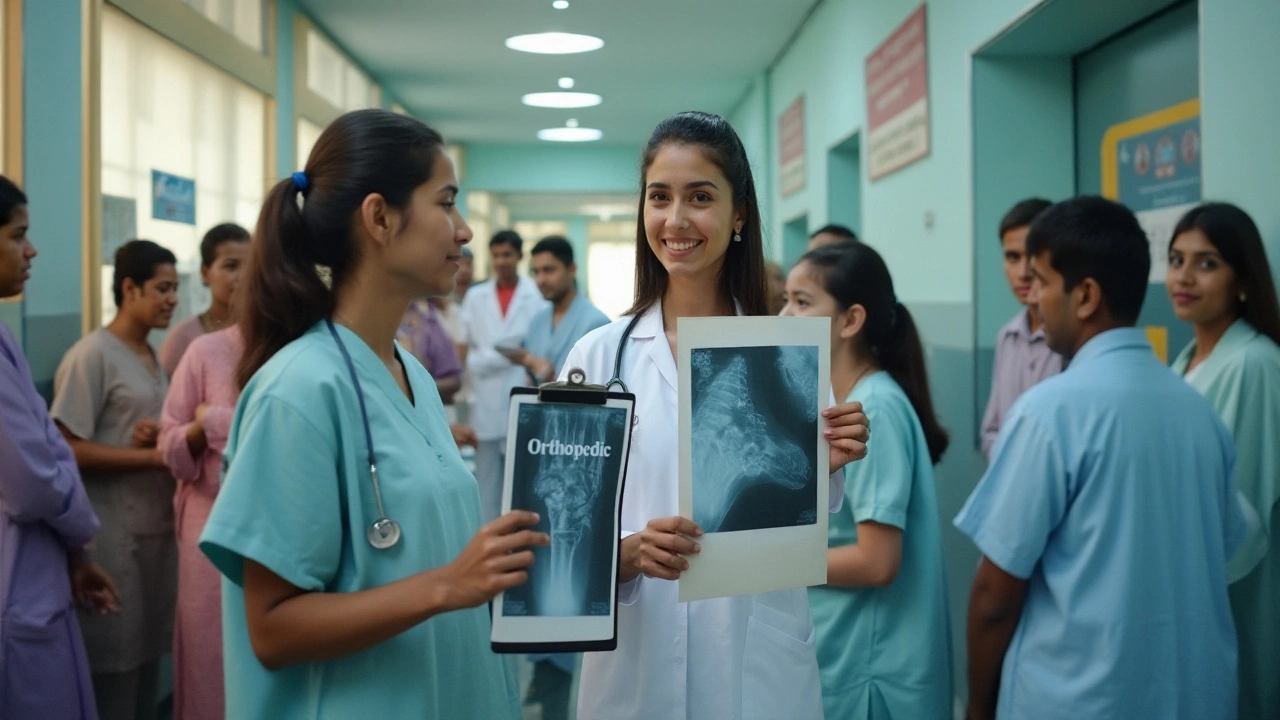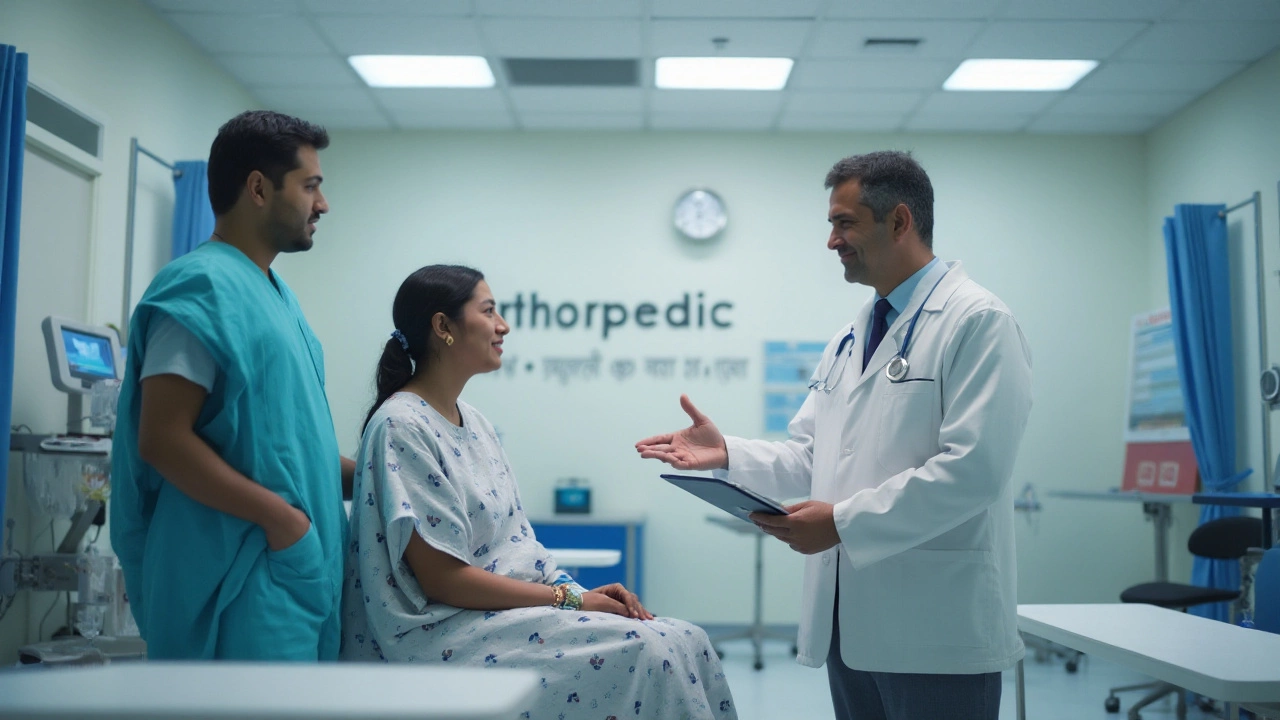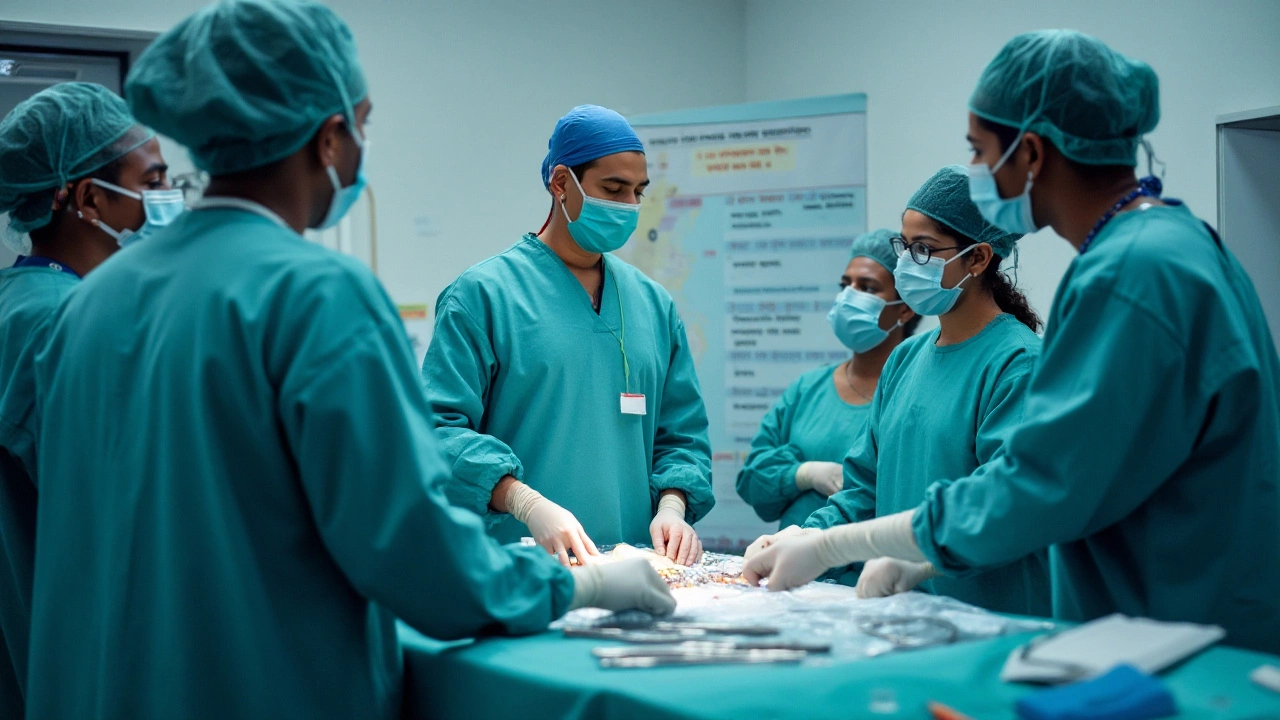
When you first encounter the words 'orthopedic' and 'orthopaedic,' you might wonder if there's more to them than just a difference in spelling. Interestingly, these terms are deeply rooted in language and geography, representing the same medical specialty but with regional preferences. Americans lean toward 'orthopedic,' while the British and others favor 'orthopaedic.'
Despite the spelling variation, both are dedicated to the study and treatment of the musculoskeletal system, including bones, joints, and muscles. This article embarks on a journey to unravel their histories, demystifying everything from the words' origins to their applications in modern healthcare. Whether you're a patient seeking guidance or a curious learner, this read promises clarity and insight.
- Origins and Etymology
- Regional Usage Differences
- Orthopedic Hospitals and Practices
- Common Treatments and Conditions
- Patient Experiences
- Choosing the Right Specialist
Origins and Etymology
The story of the words orthopedic and begins in the age-old pursuit of understanding our skeletal musculoskeletal system. Both terms draw their roots from the Greek words 'orthos,' meaning correct or straight, and 'paidion,' meaning child. The concept of orthopedics is tied closely to correcting deformities in children. This lineage is intertwined with the work of Nicolas Andry, a French physician who in 1741 published a book titled 'L'Orthopédie.' Andry's work primarily focused on preventive measures and corrections of skeletal problems using non-invasive techniques.
After its introduction to English, the word maintained its French-inspired spelling, 'orthopaedic,' a form still revered and used by many countries influenced by British English. This version emphasizes the traditional aspect of the craft, much like how the English language holds onto its Norman and Greco-Latin heritage. Meanwhile, across the Atlantic, Americans began simplifying spellings in the 19th century, trimming away what they viewed as superfluous letters to streamline communication. Hence, 'orthopedic' emerged, aligning with other simplified spellings from color to theater.
Interestingly, the debate over spelling isn't just academic. It reflects broader cultural approaches to healthcare and education, underscoring the balance between tradition and innovation. Some purists may argue that 'orthopaedic' holds an air of authenticity and comprehensiveness, while others see 'orthopedic' as modern and efficient. There's a certain charm in saying, «Language is the road map of a culture. It tells you where its people come from and where they are going,» as author Rita Mae Brown once put it. This dichotomy captures more than just letters; it embraces entire philosophies surrounding healthcare and cultural identity.
Despite the variances in spelling, both terms have been widely accepted in the medical field. However, understanding their historical and linguistic backgrounds affirms how language evolves in tandem with our societal needs. Whether you reside in a country favoring orthopaedic or one where orthopedic reigns supreme, the goal remains the same: to provide optimal care and solutions for musculoskeletal issues. As such, this knowledge is not only fascinating but vital for appreciating the rich tapestry of our linguistic and medical history.
While these origins provide context for the orthopedic and orthopaedic dichotomy, modern usage has sometimes blurred the lines. Medical practitioners across the globe continue to use both terms interchangeably, adapting to regional preferences while maintaining a focus on the essential work of healing and improving lives. The duality reflects the unity in their mission, serving as a reminder that beneath the spelling lies a universal dedication to patient care and wellbeing.
Regional Usage Differences
In the realm of language, variations in spelling often emerge due to historical influences and regional preferences. The words orthopedic and orthopaedic are quintessential examples of such diversity. The origin of both terms finds its roots in the Greek words 'orthos', meaning correct or straight, and 'paideia', meaning rearing of children. Initially, orthopaedics was focused on treating spine and limb deformities in children. However, as the field evolved, so did its scope—and the way its name was spelled across different regions.
In the United States, the spelling 'orthopedic' became prevalent primarily because of the country's inclination towards simplifying language. It's an American trend in various instances, like the transformation from 'colour' to 'color.' This form of the word can be tracked back to prominent American publications and medical texts that chose a straightforward approach for wider comprehension and ease of communication. On the other hand, countries like the United Kingdom, Canada, and Australia tend to use the original Greek-influenced spelling 'orthopaedic.' Interestingly, while many institutions and practitioners employ the British spelling to signify affiliation with traditional practices, some have embraced the American version due to the influence of American media and pop culture spreading globally.
"The language we speak and the words we choose in medical contexts reflect not just accuracy but also our cultural identity and professional affiliations," comments Dr. Emily Clarke, a renowned linguist specializing in medical terminology.
Another peculiar aspect of these regional differences is visible in branding and marketing. Often, how a hospital or clinic spells 'orthop(a)edic' can hint at its foundational philosophies or intended audience. For example, a clinic operating internationally might adopt both spellings, targeting clients from varied backgrounds. Besides, digital searches and SEO strategies necessitate the use of both variations to attract a broad spectrum of visitors seeking orthopedic care.
Understanding these nuances can be paramount when finding reputable resources or professionals on the internet, as using the term associated with your region might yield more relevant results. To illustrate, an online query 'orthopedic hospital' predominantly returns American institutions, while 'orthopaedic' features clinics and facilities from the UK and other Commonwealth countries more prominently. Both systems, though different in spelling, champion the essence of healthcare—dedication to correcting musculoskeletal issues for a better quality of life.
Notably, education systems, medical councils, and professional associations in each region reinforce the specific spelling through curriculums and official documentation. This consistency contributes to a pervasive understanding among local practitioners and patients, ensuring clarity in communication about vital medical services without confusion. As such, patients seeking orthopaedic expert opinions from international professionals might observe the intertwining use of these terms, reflecting both globalized medical practices and varied linguistic heritage.

Orthopedic Hospitals and Practices
Orthopedic hospitals and practices are specialized healthcare facilities that focus exclusively on the diagnosis, treatment, rehabilitation, and prevention of diseases and injuries of the musculoskeletal system. This includes everything from fractures and sprains to joint replacements and spinal deformities. A key characteristic of these institutions is their multidisciplinary approach, bringing together a team of specialists including surgeons, physical therapists, occupational therapists, and sports medicine experts. The collaborative effort ensures comprehensive care for each patient, addressing specific medical needs and customizing recovery programs. With the advent of cutting-edge technology, many orthopedic practices are now offering minimally invasive procedures, which enhance recovery times and reduce hospital stays, allowing patients to return to their daily activities sooner.
In the US, the spelling variation 'orthopedic' is more prevalent, and these hospitals are equipped with modern surgical amenities and state-of-the-art operational theaters that attract patients from around the globe. For those with conditions such as arthritis or traumatic injuries, these hospitals provide not only surgical solutions but also advanced rehabilitation options. Physical therapy, aquatic therapy, and pain management programs are essential components of the care regimen. The facilities also collaborate extensively with research institutions to keep abreast of new treatments and innovations, which further empowers them to offer top-notch services. Notably, many reputable orthopedic facilities employ advanced imaging techniques like MRI and CT scans, which are pivotal in accurate diagnosis.
In contrast, the 'orthopaedic' spelling is typically associated with British English and is common in regions such as the UK, Australia, and India. These centers are often involved in extensive community outreach programs aimed at educating the public on joint health and physical fitness. Services provided not only cover conventional orthopaedic surgery but also embrace holistic approaches, integrating acupuncture, chiropractic care, and nutritional counseling to foster a well-rounded recovery process. A focus on lifestyle changes empowers patients to take proactive steps in their health journey, enhancing treatment efficacy and outcomes. Additionally, many orthopaedic institutions offer telemedicine services and virtual consultations, breaking down geographical barriers and making expert care accessible to a broader audience.
"The key to successful orthopedic care is not just in treating the condition, but in revolutionizing patient experience through cutting-edge treatment modalities," shares Dr. John Smith, a leading orthopedic surgeon at a renowned US hospital, emphasizing the holistic approach these hospitals are increasingly adopting.
Statistics reveal a significant rise in orthopedic conditions worldwide, with injuries from sports and recreational activities contributing substantially to the demand for specialized care. For instance, according to a 2023 report by the American Academy of Orthopedic Surgeons, knee injuries remain the most common orthopedic ailment in athletes, underscoring the growing need for proactive and preventative care measures in sports medicine departments of these hospitals. This trend highlights the critical role of orthopedic hospitals and practices in enhancing quality of life and mobility for millions.
Common Treatments and Conditions
In the vast field of orthopedic and orthopaedic medicine, a multitude of treatments address the array of conditions affecting the musculoskeletal system. Physicians in this specialty often encounter complaints related to bones, joints, muscles, ligaments, and tendons, tackling everything from minor sprains to significant traumas like fractures. The approach to treating these conditions has evolved remarkably over the years, with innovations leading to minimally invasive procedures and more efficient recovery protocols. A significant portion of the treatments strives to restore function, relieve pain, and improve quality of life. Key strategies include physical therapy, medication, surgical interventions, and comprehensive rehabilitation.
Fractures are among the most frequently treated conditions globally. Skilled surgeons employ casting, bracing, and sometimes surgical plates and screws to ensure bones heal correctly. For those with degenerative joint diseases like osteoarthritis, joint replacement surgeries have become a beacon of hope, restoring mobility and alleviating chronic pain. In the world of sports, anterior cruciate ligament (ACL) injuries are dishearteningly common, especially among athletes. Treatment often involves reconstructive surgery, coupled with intensive rehabilitation, allowing athletes to return to their passions at peak performance levels.
Management of Arthritis
Arthritis, particularly among aging populations, continues to be a predominant concern. Osteoarthritis and rheumatoid arthritis are distinct in their manifestations and management. While osteoarthritis signifies the wear and tear of joint cartilage, rheumatoid arthritis involves an autoimmune response. Different therapeutic approaches are necessary, ranging from anti-inflammatory medications to more innovative biologic agents. Weight management and tailored exercise programs also play central roles in mitigating symptoms and halting disease progression.
Advances and Innovations
The exciting world of orthopedics is constantly evolving with technological advancements. Robotics and computer-assisted surgeries are paving the way for precision in joint replacements. These technologies, coupled with enhanced imaging and 3D printing, allow for custom prosthetics that fit patients more naturally. "The developments in orthopaedic surgery have revolutionized patient outcomes, offering enduring solutions to chronic problems," says Dr. Jane Andrews, a leading expert in the field, echoing the enthusiasm within the community.
Understanding these healthcare interventions thoroughly can empower patients and families, enabling informed decisions and realistic expectations from treatments. With each data-driven innovation, the goal remains to restore a sense of normalcy and activity in the lives of those we serve. It is a collaborative journey, often involving a multidisciplinary team, ensuring that patient-centric care is always at the forefront.

Patient Experiences
Visiting an orthopedic or orthopaedic specialist often marks a significant chapter in a patient's healthcare journey. What's most remarkable is how these experiences can vary widely, yet often share common elements of anxiety, relief, and transformation. Patients typically seek treatment for a variety of musculoskeletal issues ranging from joint pain to more complex spinal problems. One common thread is the anticipation surrounding initial consultations. Many patients express anxiety before their first visit, worried about potential diagnoses and treatment plans. However, they often find comfort in the expertise and reassurance offered by their orthopedic doctors. These specialists excel not only in medical treatment but also in fostering environments where patients feel heard and supported.
The treatments patients receive in orthopedic hospitals span an impressive scope. From conservative approaches such as physical therapy and pain management to sophisticated surgical procedures, the goal remains to enhance mobility and alleviate pain. After the initial diagnosis, patients usually engage in thorough discussions with their healthcare providers about their tailored treatment plans. These discussions help demystify complex medical information, providing patients with both knowledge and empowerment. Anecdotal evidence suggests that being well-informed helps patients cope better with their conditions, fostering a sense of agency over their health outcomes.
A critical aspect of the patient experience in orthopedics is post-treatment care, where the journey does not end with a surgery or a single appointment. Recovery can involve weeks or even months of rehabilitation, requiring patience and determination. Many patients note the profound change in their quality of life post-treatment. Successful interventions can lead to regained physical abilities, allowing individuals to return to activities they once enjoyed, whether it's playing sports, climbing stairs with ease, or simply living without chronic pain. It is important to note that outcomes can vary depending on several factors, including the nature of the condition and individual patient circumstances.
Personal stories often highlight the emotional and psychological impacts of orthopedic care. Patients frequently report feeling a mix of vulnerability and hope, and some have even shared their profound gratitude towards their care team. The multi-disciplinary nature of orthopedic hospitals, involving surgeons, nurses, physical therapists, and support staff, contributes to a comprehensive care experience. As a patient recovers, the support from medical professionals and family alike plays a pivotal role, reinforcing that recovery is as much a collective effort as it is a personal one.
"Every step of the way, I was met with reassurance and expertise. My care team made a daunting process seem manageable and tailored every aspect to suit my needs," shared Helen Peterson, a patient speaking about her experience at a leading orthopedic hospital.
Statistical data reflects the positive patient experiences associated with orthopedic care. A recent survey from the National Institute of Health highlighted that over 80% of individuals reported significant improvements in their health following orthopedic surgeries. Such findings underscore the efficacy of specialized care and the diligent efforts of healthcare professionals to improve patient outcomes. Ultimately, patient experiences in both orthopedic and orthopaedic settings can serve as powerful testimonies to the impact of dedicated medical care, marking significant chapters of hope, recovery, and renewed vitality.
Choosing the Right Specialist
Selecting the right orthopedic or orthopaedic specialist can be a significant decision with far-reaching consequences for your health and well-being. The journey often starts with referrals from family doctors, friends, or even online reviews. However, understanding your needs and the specialties of these experts is quintessential in ensuring you receive the appropriate care. Most specialize in particular areas such as joint replacement, sports medicine, or pediatric orthopedics, so your choice may depend heavily on your specific condition.
Research indicates that patients who actively participate in choosing their healthcare providers often report higher satisfaction levels. A meticulous approach involves checking the doctor’s credentials, experience, and patient feedback. The American Academy of Orthopaedic Surgeons (AAOS) offers a wealth of resources online for those navigating this important choice. It's fascinating how online communities and forums have become invaluable resources for many, offering firsthand patient experiences as guidance.
“An informed patient is an empowered patient,” says Dr. John Smith, a leading figure in the field with over 20 years of experience. “Knowing what questions to ask and understanding the scope of treatment options is crucial.”
Cost can be another factor influencing your decision. Specialists under insurance networks might be preferable for those looking to manage expenses effectively. However, some patients opt for out-of-network experts if they perceive them to offer better or more specialized care. Knowing the insurance landscape is vital, as policies vary widely in their coverage for orthopedic treatments.
Once you have shortlisted potential specialists, preparing a list of questions can help narrow down your choices. Consider discussing their approach to treatment, recovery times, potential risks, and success rates of previous surgeries. Engaging with the doctor during initial consultations gives you a better sense of their bedside manner and how comfortable you feel under their care. Another critical aspect is the alignment of their treatment recommendations with your personal goals and lifestyle, ensuring realistic expectations for recovery and activity levels post-treatment.
Finally, the location and facilities of the orthopedic hospital or clinic are also worth considering. Modern facilities, advanced technology, and ease of access, particularly for follow-up visits, can be decisive factors. Building a rapport with the healthcare team rounds out this decision-making process, as successful treatments often involve a collective effort. Remember, the right specialist not only addresses your current health needs but also supports your long-term well-being.





Rohan Talvani
I am a manufacturing expert with over 15 years of experience in streamlining production processes and enhancing operational efficiency. My work often takes me into the technical nitty-gritty of production, but I have a keen interest in writing about medicine in India—an intersection of tradition and modern practices that captivates me. I strive to incorporate innovative approaches in everything I do, whether in my professional role or as an author. My passion for writing about health topics stems from a strong belief in knowledge sharing and its potential to bring about positive changes.
view all postsWrite a comment